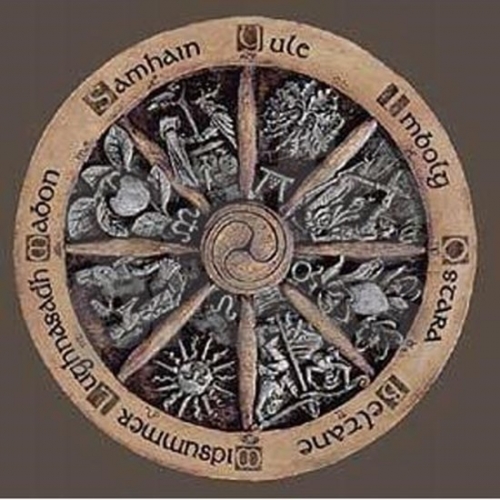By Charles Squire
From Celtic Myth and Legend [1905]
Whatever may have been the exact meaning of the Celtic state worship, there seems to be no doubt that it centred around the four great days in the year which chronicle the rise, progress, and decline of the sun, and, therefore, of the fruits of the earth. These were: Beltaine, which fell at the beginning of May; Midsummer Day, marking the triumph of sunshine and vegetation; the Feast of Lugh, when, in August, the turning-point of the sun’s course had been reached; and the sad Samhain, when he bade farewell to power, and fell again for half a year under the sway of the evil forces of winter and darkness.
Of these great solar periods, the first and the last were, naturally, the most important. The whole Celtic mythology seems to revolve upon them, as upon pivots. It was on the day of Beltaine that Partholon and his people, the discoverers, and, indeed, the makers of Ireland, arrived there from the other world, and it was on the same day, three hundred years later, that they returned whence they came. It was on Beltaine-day that the Gaelic gods, the Tuatha Dé Danann, and, after them, the Gaelic men, first set foot on Irish soil. It was on the day of Samhain that the Fomors oppressed the people of Nemed with their terrible tax; and it was again at Samhain that a later race of gods of light and life finally conquered those demons at the Battle of Moytura. Only one important mythological incident–and that was one added at a later time!–happened upon any other than one of those two days; it was upon Midsummer Day, one of the lesser solar points, that the people of the goddess Danu took Ireland from its inhabitants, the Fir Bolgs.
The mythology of Britain preserves the same root-idea as that of Ireland. If anything uncanny took place, it was sure to be on May-day. It was on “the night of the first of May” that Rhiannon lost, and Teirnyon Twryf Vliant found, the infant Pryderi, as told in the first of the Mabinogion. It was “on every May-eve” that the two dragons fought and shrieked in the reign of “King” Lludd. It is on “every first of May” till the day of doom that Gwyn son of Nudd, fights with Gwyrthur son of Greidawl, for Lludd’s fair daughter, Creudylad. And it was when she was “a-maying” in the woods and fields near Westminster that the same Gwyn, or Melwas, under his romance-name of Sir Meliagraunce, captured Arthur’s queen, Guinevere.
The nature of the rites performed upon these days can be surmised from their pale survivals. They are still celebrated by the descendants of the Celts, though it is probable that few of them know–or would even care to know–why May Day, St. John’s Day, Lammas, and Hallowe’en are times of ceremony. The first–called “Beltaine” in Ireland, “Bealtiunn” in Scotland, “Shenn da Boaldyn” in the Isle of Man, and “Galan-Mai” (the Calends of May) in Wales–celebrates the waking of the earth from her winter sleep, and the renewal of warmth, life, and vegetation. This is the meaning of the May-pole, now rarely seen in our streets, though Shakespeare tells us that in his time the festival was so eagerly anticipated that no one could sleep upon its eve. At midnight the people rose, and, going to the nearest woods, tore down branches of trees, with which the sun, when he rose, would find doors and windows decked for him. They spent the day in dancing round the May-pole, with rude, rustic mirth, man joining with nature to celebrate the coming of summer. The opposite to it was the day called “Samhain” in Ireland and Scotland, “Sauin” in Man, and “Nos Galan-gaeof” (the Night of the Winter Calends) in Wales. This festival was a sad one: summer was over, and winter, with its short, sunless days and long, dreary nights, was at hand. It was the beginning, too, of the ancient Celtic year, and omens for the future might be extorted from dark powers by uncanny rites. It was the holiday of the dead and of all the more evil supernatural beings. “On November-eve”, says a North Cardiganshire proverb, “there is a bogy on every stile.” The Scotch have even invented a special bogy–the Samhanach or goblin which comes out at Samhain.
The sun-god himself is said to have instituted the August festival called “Lugnassad” (Lugh’s commemoration) in Ireland, “Lla Lluanys” in Man, and “Gwyl Awst” (August Feast) in Wales; and it was once of hardly less importance than Beltaine or Samhain. It is noteworthy, too, that the first of August was a great day at Lyons–formerly called Lugudunum, the dún (town) of Lugus. The mid-summer festival, on the other hand, has largely merged its mythological significance in the Christian Feast of St. John.
The characteristic features of these festivals give certain proof of the original nature of the great pagan ceremonials of which they are the survivals and travesties. In all of them, bonfires are lighted on the highest hills, and the hearth fires solemnly rekindled. They form the excuse for much sport and jollity. But there is yet something sinister in the air; the “fairies” are active and abroad, and one must be careful to omit no prescribed rite, if one would avoid kindling their anger or falling into their power. To some of these still-half-believed-in nature-gods offerings were made down to a comparatively late period. When Pennant wrote, in the eighteenth century, it was the custom on Beltaine-day in many Highland villages to offer libations and cakes not only to the “spirits” who were believed to be beneficial to the flocks and herds, but also to creatures like the fox, the eagle, and the hoodie-crow which so often molested them. At Hallowe’en (the Celtic Samhain) the natives of the Hebrides used to pour libations of ale to a marine god called Shony, imploring him to send sea-weed to the shore. In honour, also, of such beings, curious rites were performed. Maidens washed their faces in morning dew, with prayers for beauty. They carried sprigs of the rowan, that mystic tree whose scarlet berries were the ambrosial food of the Tuatha Dé Danann.






 del.icio.us
del.icio.us
 Digg
Digg
Les commentaires sont fermés.